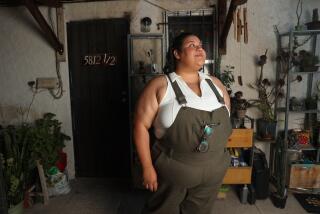WILLIAM J. POPEJOY : Partner, Butler Popejoy Group, Irvine
- Share via
As a mortgage banker and president of several savings and loans and the Federal Home Mortgage Corp., known as Freddie Mac, William J. Popejoy has long been involved in housing issues. Last July, he and real estate developer Merrill Butler, whom he worked with while trying to save American Savings & Loan, formed a company to fund affordable housing and to buy loans from thrifts and banks. He spoke with Times staff writer James S. Granelli about his company’s effort to raise $200 million to $300 million for their ventures.
Q. How much of your efforts toward looking for good investments are aimed at affordable housing?
A. We have two programs, and probably half of our effort is directed toward affordable housing. The need for affordable housing is so dramatic today, and the market is very strong. All the mechanics are in place: cheap land, affordability because of lower interest rates for mortgages and just the general need for housing, say, from $100,000 to $175,000. The problem, which makes it an opportunity for us, is that the financing isn’t there for the development of such housing. I shouldn’t say it isn’t there, but it’s very difficult for developers to get the financing to develop a piece of property today.
Q. When do you think you’ll have some affordable housing projects lined up? Do you have a target date?
A. We’re already behind schedule. So I’m reluctant to come up with new targets that we can’t meet. I’d be very surprised if the program isn’t off the ground by midyear. If it isn’t, we probably shouldn’t pursue it because we’ve spent a great deal of time and money. We’ve made many trips to the East Coast and to Washington, a number of trips to Europe, to develop the investor awareness. It’s a sales job.
Q. So you looked for financing before searching for a project?
A. Yes. In fact, our project gathering process has basically just now begun. We started once earlier and we simply thought we were approaching it in the wrong manner. Now, Merrill and I will be meeting with builders, probably within the next couple of weeks. We’ve had conversations with these builders. Letters will be going out to specific builders asking them to take a look at our program and to see if they have an interest. That is something that is going out right away. In fact, it’s being reviewed now by our accountants and our attorneys.
Q. Any idea where those projects might be?
A. Well, I think the ones we’re initially looking at are primarily in California. A number of them in Northern California, but some in Southern California. We haven’t really had any great interest shown by some of the out-of-state developers, which surprised us a little bit. However, the kind of program we’re talking about, even if we put out $200 million, I mean, you could do that easily in California. We’re only talking about 2,500 units. And that’s not going to happen all at once. We cannot solve the problem. We think that we can contribute to an improvement in the situation and that we also can have a small operation in which Merrill and I are personally involved. That’s important to us because the investors that we’ve been talking to seem to be very pleased with us. So if we have their trust, then we don’t want to lose it.
Q. Since developers find it difficult to get financing from banks and S&Ls;, are companies like yours the only place left for them?
A. I think for the immediate future, the answer is yes because we have this “circle of paralysis,” for want of a better word. I’m not sure there’s any guilty party, but it starts with the taxpayers who are extremely upset about paying for the S&L; bailout, and maybe paying for the bank problems in the future. They’re putting tremendous pressure on their elected representatives, basically in Congress. Congress, therefore, puts tremendous pressure on the regulators not to let this happen again. The regulators put tremendous pressure on the banks and the S&Ls; not to make any kind of loan that is risky. As a consequence, you have this cycle where the money’s just not available for even very good loans. So there’s a window of opportunity for other investors. I think that over time, maybe the Clinton Administration, in an effort to get the economy moving, will break that cycle and start to encourage banks to make good quality loans for real estate development. I think it’s going to be some while--months and maybe years--before it’s really put in place.
Q. What are you looking for in an affordable housing project?
A. We believe there are still strong opportunities for lower-priced or affordable housing to be built quickly. The key is that the property has to be ready to be built upon. Entitlements have to be in place. You can’t take the chance of waiting months and years to see if something’s going to be approved. Fortunately, there’s a lot of land today, even in Southern California, that’s ready to be built upon. That’s one critical feature. Next: price. The developers who bought land in 1987-88 probably have the property, that inventory, way under water today. And so you have the government and others selling property at 50% or less than what it sold for three years ago.
Q. And the land is ready?
A. You have entitlements in place, you have land at very low cost and you have a building industry--the crafts, the subcontractors--anxious to go to work. So you have a price structure that makes the likelihood of providing a product that is affordable and of good quality extremely likely. We’re talking about, not hundreds of thousands of units, but, in an average year, about 20,000 to 30,000 units in California alone. Our own program contemplates financing maybe 2,000 to 3,000 units in five states. So we’re talking a very small percentage.
Q. There is a lot of money around for mortgages, but none to build a house.
A. That’s right. That is the craziness of what we’re saying. We have financing available for mortgages, but no financing available to build the homes, to create the mortgages.
On affordable housing being a good opportunity.
“It’s a worthwhile thing to do. You can earn a good return but, more importantly, you can feel pretty good about what you’re doing.”
On out-of-state competition.
“It’s hard to compete. In Arizona, the cost of occupancy, the cost of workers’ compensation, the cost of insurance, the cost for the work force to occupy homes are all cheaper.”
On the growing loss of middle-class workers.
“If you widen the gap between the haves and the have-nots, you increase the potential for crime and you just have a recipe for disaster.”
On closing the rich-poor gap.
“You need to provide lower- income people opportunities to grow into middle income. You have to give them a shot at achieving the economic comfort level that they wish.” “
More to Read
Inside the business of entertainment
The Wide Shot brings you news, analysis and insights on everything from streaming wars to production — and what it all means for the future.
You may occasionally receive promotional content from the Los Angeles Times.










